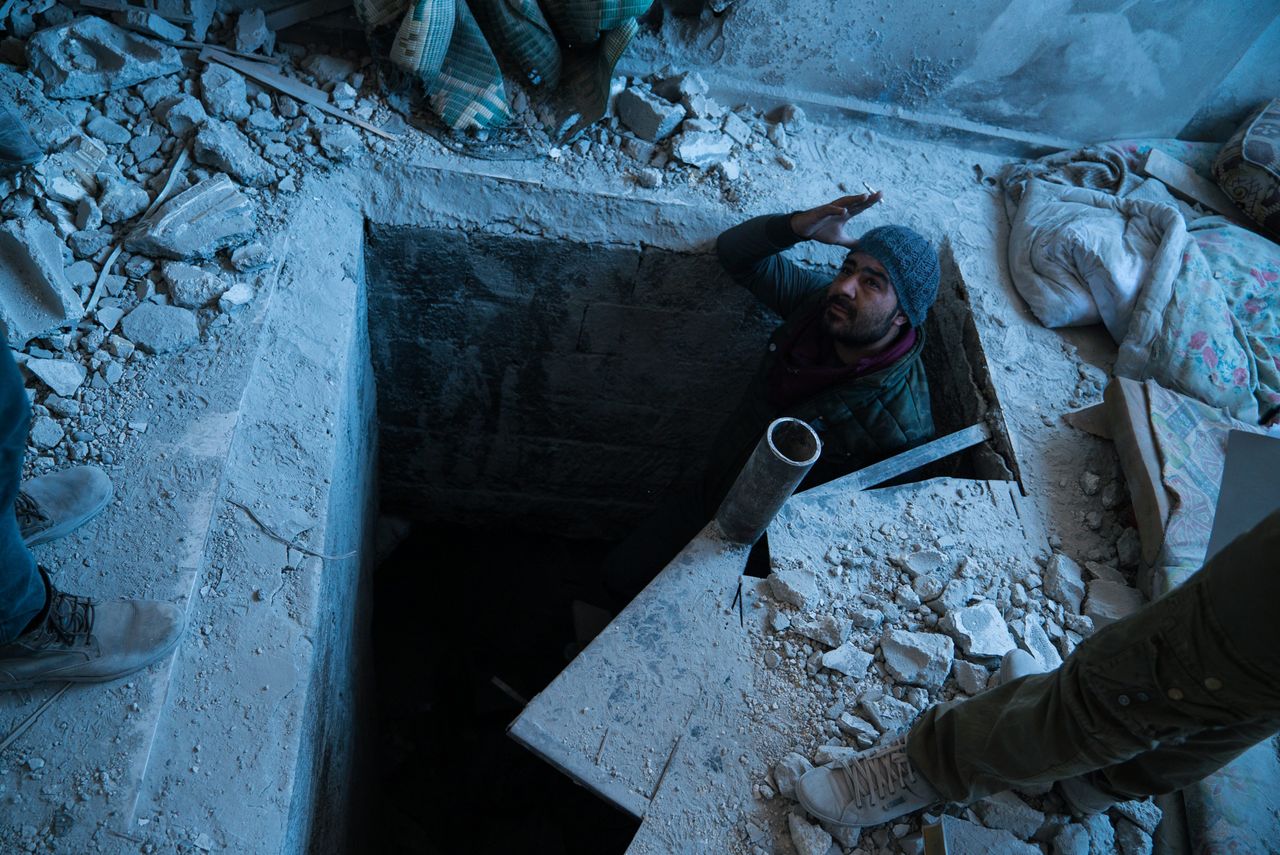
On October 17, 2017, Raqqa was recaptured from the hands of jihadists by the troops of Syrian Democratic Forces and the with support of the Americans. The Caliphate left IEDs (Improvised Explosive Device) spread all over the self-proclaimed capital of ISIS. The jihadists left numerous underground tunnels as well. What were they used for?
On the ground floor there is a room and a rectangular hole with dimensions two meters long and one meter wide. Metal stairs are attached to it and they lead down into complete darkness. Because of an international coalition air raids on Raqqa, led by the United States, the roof of the building collapsed, and the falling debris destroyed almost all the steps. Only one was left, just in the middle, about one and a half metre from the surface and three meters from the entrance to the tunnel.
28-years-old Shivan (he does not want to reveal his real name) squats and lowers his legs slowly towards the step. Only his head in a hat can be seen from the darkness.
The man explains that the tunnel was excavated a year ago. Shivan lives nearby, so he could see through his window that an ISIS car parked outside regularly around 10:00 p.m. and it drove off later. It was a pickup with its back covered with a tarp. It was not possible to say what was under the tarp.
– We knew it was their car, and if they came here so often, then there must have been a tunnel there – says Shivan.
Moreover, it was not the only car that regularly ran in that area. A second pickup parked under the nearby house, and it drove away later loaded with some sugar bags. It aroused suspicions among the inhabitants. Eventually it became clear that there was soil in the bags, excavated while digging tunnels.
However, the ISIS fighters did not manage to move all the soil from the mined tunnel. There are flats with the entrances to the tunnels, where 40-centimetres-high piles of tiled soil can still be found. The fighters did not take the piles outside. Civilians could have noticed the piles, or they might have been spotted from the air.
A suicide vest, the mattresses and urine bottles
There are at least thirty tunnels in the area where Shivan lives. Their number in Raqqa is unknown. They are not connected to each other. Some are few meters long and the length of others is about several hundred metres. The tunnels were used in different ways: as an effective protection during air raids, to surround and surprise the opponent’s forces entering the city, to store stocks and weapons or as a place of quartering the fighters. Some tunnels had restrooms and medical stations. It is said that there are two cities of Raqqa – the one on the surface and the one underground.
Shivan shows us the second entrance to the tunnel. The structure is solid and professionally made. The entrance is walled-up. The tunnel itself is panelled in reinforced concrete elements, which insertion into the narrow passage was certainly not easy. Shivan mentions that he entered the tunnel for the first time with his friend, two or three weeks after the city had been captured by the Syrian Democratic Forces (SDF).
– We had to check what was inside, if anyone from Daesh was hiding there – says Shivan.
After a while, he adds that it was mainly curiosity that led them to check the inside of the tunnel, the desire to see the place that no one has seen before. They did not carry weapons with them.
The tunnel is about one and a half meters high and one meter wide. It is 300 metres to 400 metres long. It has two entrances. There are three rooms with mattresses, pillows, blankets, clothes, some food leftovers and bottles of urine. There is also an electrical installation there, but it is out of order.
Shivan and his friend found a suicide vest in the tunnel. It is also called a suicide belt, an explosive belt, or a shahid belt. The vest, or the belt, has some explosive materials attached, and the word “shahid” means a martyr. They also found a strange device – they were afraid to touch it, because it could have been an IED. There are plenty of them in Raqqa. The men returned to the tunnel after a week but none of these things were there any longer. They do not know who took them. They claim that it could have been either the SDF security service, or the owners of these items. And they might still be met in tunnels from time to time.























